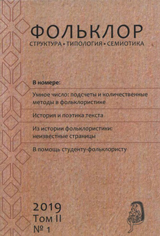
The academic journal “Folklore: Structure, Typology, Semiotics” introduces the reader to the results of fundamental research in theoretical folklore studies. It publishes papers dedicated to studies of oral texts and ritual practices, of the archaiс myth and its contemporary modifications, including those in the wider interdisciplinary context altogether with discussing folklore problematics outside the borders of the “realm” of folklore studies.
Each issue of the journal consists of a main themed rubric with short notes “from the researcher’s desk”. Besides, the journal includes essays on world folklore, field and archive data, papers and materials on the history of folklore studies, reviews, bibliographies, reviews of books on folklore studies, reports and announcements of scholarly events. In the future, the journal aims to inform the readers about the projects dedicated to studying of folklore and mythological traditions, to also inform about research centers in Russia and abroad that dwell upon the issues of comparative and theoretical folklore studies, to suggest software and methodological developments for university courses in the discipline and to cover the ongoing events in academia in sufficient detail.
The journal promotes, as far as possible, the enhancement of academic communication between scholars, encourages aspiring researchers to partake in theoretical folklore studies and promotes implementation of research results into university education programs. Creators and editors of the journal, united in the shared understanding of their research subjects and methodological principles developed during the decades of this research school’s existence, respect alternative views on the problematics of folklore studies, other schools of research in oral traditions and implementation of other methodology as long as it is based on correct procedures compliant with contemporary academic knowledge. This principle lies in the core of the journal’s editorial policy.
There are 4 issues per annum (double issues are possible) which comprise a volume. Each issue makes up to 400 000 characters. All submissions undergo anonymous peer review. The journal is pro bono and, with few exceptions, does not accept illustrations in color. Submissions are accepted not only in Russian but also in other languages, primarily in English.
The journal is intended for scholars in folklore and folk culture, undergraduate and PhD students and any reader interested in these topics.
























